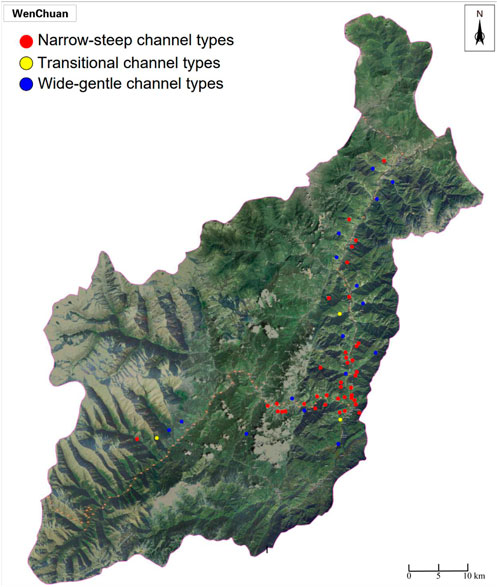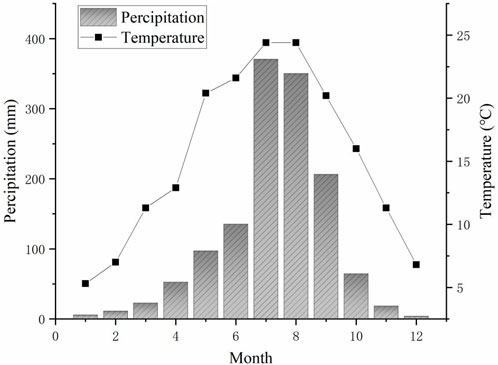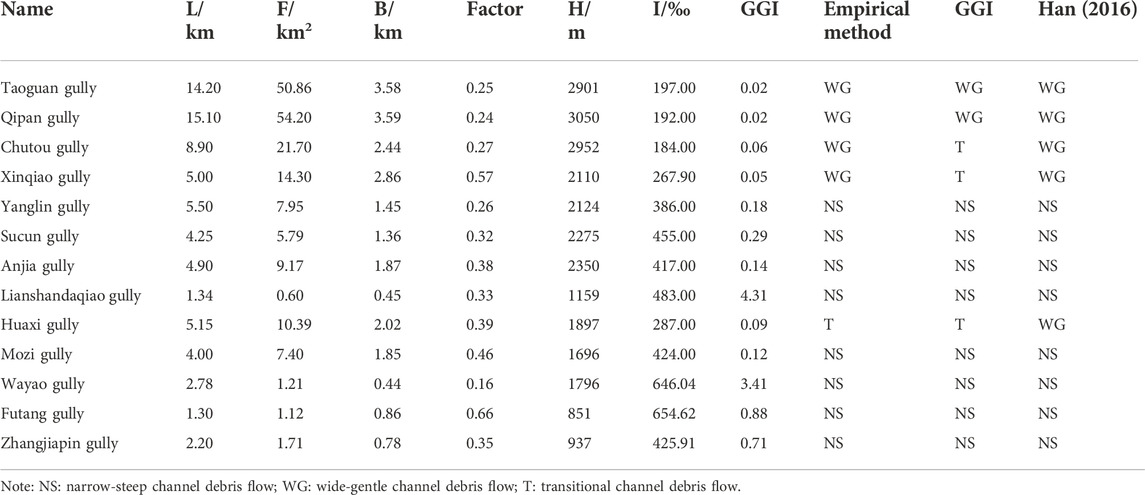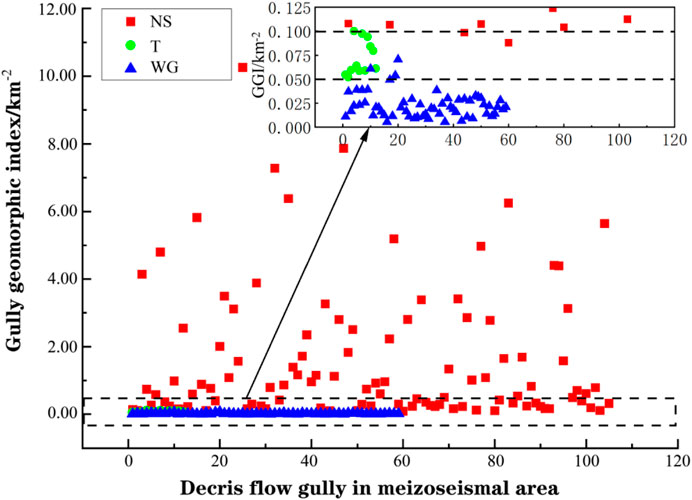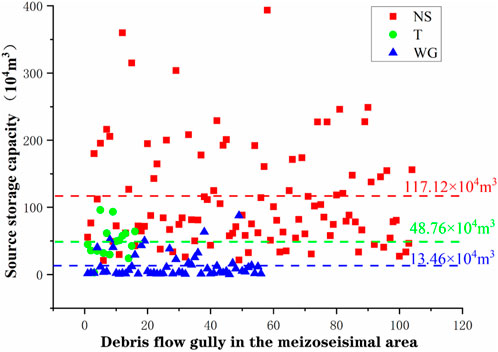- 1State Key Laboratory of Hydraulics and Mountain River Engineering, Sichuan University, Chengdu, China
- 2College of Water Resource and Hydropower, Sichuan University, Chengdu, China
- 3Sichuan Water Resources and Hydroelectric Investigation & Design Institute Co, Ltd, Chengdu, China
- 4Yalong River Hydropower Development Company, Ltd, Chengdu, China
The debris flow disasters in the Wenchuan meizoseismal area are dominantly triggered by the gully-type debris flow. Research on its classification method can be of great theoretical value and practical significance for developing targeted prevention measures. The current empirical classification method has some disadvantages, such as inconsistent discrimination criteria and poor practicability. In this paper, in order to overcome these drawbacks, the topography, rainfall, and source characteristics data of 176 gully-type debris flows in the Wenchuan “5.12” meizoseismal area since 2008 were collected and divided into the narrow-steep, transitional, and wide-gentle types based on field investigation. The narrow-steep type gullies are mainly concentrated in small catchments with severe erosion. In contrast, the wide-gentle type gullies are often characterized by big catchments, gentle vertical slopes, and debris flows movement dominated by deposition. An empirical discrimination method for debris flow gullies is proposed based on the characters of the gullies in the meizoseismal area, and a mathematical discrimination model named Gully Geomorphology Index (GGI) is also constructed. The results from existing cases indicated that both methods were accurate to discriminate between the narrow-steep and wide-gentle debris flow gullies. According to the empirical discrimination method, among the 176 channel-type debris flows, the numbers of narrow-steep, transitional, and wide-gentle channel types are 105 (59.66%), 12 (6.82%), and 59 (33.52%), respectively. While for the GGI method, the value 0.05 and 0.10 were defined as the threshold of the three types, and the distribution of the results is 104 (59.09%) for the narrow-steep type, 16 (9.09%) for the transitional type, and 56 (31.82%) for the narrow-steep type, which can better classify the transitional type gullies and is more practical. We hope that the discrimination methods proposed in this paper will help better understand the disaster-causing mechanism and improve the prevention measures of debris flow in the Wenchuan meizoseismal area.
1 Introduction
Since the 2008 “5.12” earthquake, mega flash floods and debris flows have occurred in Wenchuan, Dujiangyan, Mianzhu, and other strong seismic regions for many years, causing huge losses to local people’s lives and properties (Fan et al., 2018). Debris flow is one of the main types of post-earthquake secondary disasters, of which abundant source material was produced and the critical rainfall threshold was consequently reduced by the activating effect of the earthquake (Koi et al., 2008; Wu et al., 2011; Tang et al., 2012; Yin et al., 2015; Qi et al., 2020). Many researchers have studied the area. Lombardo et al. (2019) retrieved the pattern of the ground motion through the landslides the Wenchuan earthquake itself triggered. Loche et al. (2022) studies the post-seismic response of a small area. According to the previous studies, the active period of debris flow after the earthquake will be 5–30 years (Tang et al., 2009; Huang and Li 2014; Zhang et al., 2014; Xiong et al., 2020), so it can be seen that the Wenchuan meizoseismal area is still in the high incidence period of post-earthquake debris flow. Debris flow gully can be generally divided into formation area, circulation area and accumulation area (Qu and Xiao, 2018). As the Wenchuan meizoseismal area is located in China’s one and two-step boundary line in the Hengduan mountain range, the valleys are steep, the generation and concentration of runoff are urgent. Therefore, the outbreak of debris flow in this region after the earthquake is likely to be the gully type. Due to the different geomorphological characteristics of different channels, the formation of the channel debris flow disaster-causing mechanism and disaster-causing mode also differ. The current debris flow discrimination method have been unable to meet the requirements for the meizoseismal area debris flow disaster control, so there is an urgent need to effectively identify the type of debris flow to develop different types of prevention engineering in this region.
In past years, debris flow researches mainly focused on two types of debris flows: Slope debris flow and gully debris flow. Debris flows that have occurred after the Wenchuan earthquake in Southwest China have different formation mechanisms, erosion, deposition characteristics, and secondary disaster chain (Han 2016). Several research teams have studied the type of debris flows in this region. Yang et al. (2012) proposed the concept of narrow-steep channel type debris flow after studying 67 mudslide ditches that occurred in five areas of the Wenchuan meizoseismal area from 2008 to 2013 and analyzed their unique management difficulties and corresponding prevention and control countermeasures (Yang et al., 2015; Yang et al., 2020). Based on the characteristics of 13 debris flows along the Duwen Expressway in 2013, Han (2016) divided the channel-type debris flows into two categories, narrow-steep and wide-gentle, and discussed their disaster mechanism. For each of them, the prevention measures were then given by Han et al. (2018). After analyzing the parameters of 145 debris flows that erupted after the Wenchuan Earthquake, Chen et al. (2018) proposed the concept of urgent-steep gully debris flows, summarized their motion and dynamic characteristics, and Li et al. (2020) studied their initiation characteristics through flume experiment. The above-mentioned “narrow-steep” and “urgent-steep” gullies refer to a kind of debris flow gully with a small watershed area, narrow flow channel, and steep channel gradient, in which the debris flow erupts, moves swiftly and violently. The term “narrow” describes the character of the width of the overall watershed and flow channel, while “urgent” and “steep” are used to indicate both the overall and the flow channel gradient. Therefore, we use narrow-steep type to describe this kind of debris flow gully, while the gullies with opposite characteristics are defined as a wide-gentle type.
Accurate classification of gullies in the meizoseismal area can help promote the mechanistic understanding of debris flow further and thus improve engineering management. To date, the identification of gully-type debris flows in the meizoseismal area is mainly based on the empirical methods proposed by different scholars. The main defects associated with these methods include the inconsistent selection of indicators and the conflicting identification rules. In addition, the gully-type debris flows in seismic regions are mainly divided into two categories: “narrow-steep/urgent-steep/steep” and “wide-gentle.” However, field investigations found that the current empirical methods could not identify debris flows with characteristics in between. Hence, in order to address the deficiencies of the empirical discrimination method in the selection of indicators, discrimination criteria, classification, method operation, and other aspects, several improvements are made on the empirical discrimination method in this paper by combining the characteristics of the indicators of 176 debris flows in the meizoseismal areas. During the “5·12″ earthquake, Wenchuan was the area most affected by the earthquake and also had a high incidence of debris flows. Figure 1 shows the distribution of the 58 debris flow gullies in the Wenchuan area. On this basis, a gully geomorphological index (GGI) discrimination model is proposed. The results show that the model has good operability and accuracy and is of significant guidance to further research on the mechanism of disaster and its prevention and control.
2 Analysis of debris flow discriminant indicator
The quantitative indicators to describe the topography of debris flow gullies are divided into the planimetric indicators and spatial elevation indicators (Liao et al., 2011). The main indicators that can describe the feature of “narrow” are planimetric indicators, such as watershed area, watershed length, average watershed width, watershed integrity coefficient, average channel width, and main channel length. These metrics can be accessed through GIS (Chowdhuri et al., 2020; Pal et al., 2020; Roy et al., 2020). The main indicators that can describe the feature of “steep” are spatial elevation indicators, such as the relative elevation of the watershed, the average vertical slope of the catchment, and the slope of both sides of the trench. The meaning of the indicators is shown as follow:
(1) Drainage area
(2) Watershed length, average width, and watershed integrity factor: watershed length refers to the axial length of the watershed, which is generally the same as the main gully length when studying the debris flows (Wang et al., 2020). Since the watershed is mostly irregular in shape, the width characteristic is often expressed as the average watershed width
(3) Average channel width: The average channel width is mainly dependent on the watershed’s shape and the average width; it is positively correlated to the latter. The bottom width is usually measured to calculate the average width. However, most of the narrow steep debris flow gully has a profile for the V-shaped section, and the actual channel width under this section varies with the scale of the debris flow. The larger the scale, the greater the average channel width. Thus, it is difficult to determine the width of the flow channel in the event of a debris flow and unreasonable to use only the bottom width as the proxy for the average channel width. Therefore, the average watershed width is selected to represent the width information.
(4) Relative elevation difference of the catchment: the relative height difference of the watershed quantitatively reflects the spatial height variation of the debris flow gully. The more significant the difference in elevation, the greater the potential energy converted into kinetic energy, and the stronger the athletic ability for debris flow (Wang et al., 2020).
(5) Average vertical slope of the channel I: vertical slope reflects the steepness of the gully, generally using the average longitudinal ratio of the original area and circulation area to represent (Li et al., 2014; Wang et al., 2020). The high average vertical slope indicates that the gully is in the formative-developmental stage in geomorphological development. With narrow gully and severe erosion, debris flow frequently occurs (Wang et al., 2020).
In summary, we selected the watershed area, the average watershed width, the watershed integrity coefficient, and the main channel length to represent the character of width. The relative elevation of the watershed and the average vertical slope of the catchment are selected to represent the character of the slope.
3 Topographical features of the debris flow gully in the meizoseismal area
Table 1 summarizes previous studies’ existing empirical discrimination methods for debris flow gullies. Still, for many gullies, like Anjia gully (F=9.17km2, I= 434‰, δ=0.28, the width in circulation area: 10–30 m) and Bayi gully (F=8.63 km2, I=366‰, δ=0.44), they have a typical character of narrow-steep gullies such as large longitudinal gradient and narrow circulation area. Although they are not fully meeting the specific parameters given in Table 1, they should also be classified as narrow-steep gullies (Zhao et al., 2021). In addition, the different indicators and criteria proposed by other investigators may result in the same gully being classified as different types by using different empirical discrimination methods. Due to different types of gullies having different disaster-causing mechanisms, this discriminant bias will significantly impact the later theoretical research and engineering control. For instance, wide-gentle gullies are always dominated by siltation, and the treatment engineering measures are often adopted as intercepting sources in the upstream and drainage in the downstream.

TABLE 1. The existing empirical discrimination methods for channel-type debris flow in the meizoseismal area.
In contrast, for the narrow-steep gullies, erosion is the main disaster. Consolidating the slope and bed of the gully and building a retaining dam at the gully outlet are effective methods for disaster control (Han 2016). Using treatment measures without considering the gully type may cause severe damage. Taking the Wenjia gully (F=7.81 km2, L=3.25 km, H=1519 m) for example, it built many check dams to prevent the debris flow, while the debris flow occurred on 13 August 2010 filled many check dams and eventually destroyed the dams at the outlet, which caused 7 casualties, 39 injured, and 497 houses buried (Liu et al., 2017). Therefore, in order to discriminate the type of gullies more precisely, the topographical features of gullies are analyzed from six indicators based on the 176 cases.
3.1 Watershed area
The watershed area distribution of the 176 cases is shown in Figure 2, The gullies with
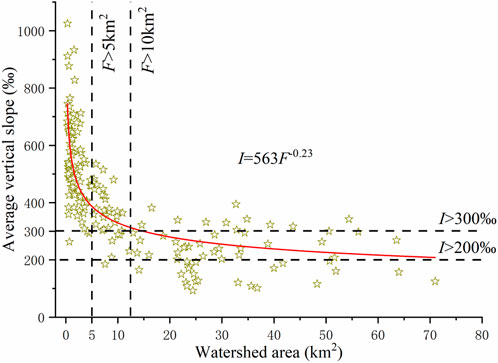
FIGURE 2. Average vertical slope versus watershed area of 176 channel-type debris flow gullies in the meizoseismal areas.
3.2 Average vertical slope of the channel
The average vertical slope of the channel is the key indicator controlling the formation and movement of debris flow. Takahashi (1980) found that when the vertical slope of the gully in the original area is above 286‰, the rainwater collected in the catchment area plays a more significant role in the occurrence of debris flows. The Institute of Mountain Hazards and Environment (IMHE) investigated the debris flow along Chengdu-Kunming railway and presented that the steep gully can be defined when the average vertical slope is greater than 250‰ (Chengdu Institute of mountain hazards and environment and Chinese Academy of Sciences, 1989); Specification of Geological Investigation for Debris Flow Stabilization (DZ/T2006) stipulates that a gully bed with a vertical slope greater than 12° (213‰) is highly susceptible to debris flow (resources 2006). Among the 176 cases in the meizoseismal area, 67.61% have an average vertical slope greater than 300‰, indicating that most debris flow gullies are steep, which endowed the debris flow a large amount of kinetic and potential energy, causing large-scale scouring and deposition. The Scholars (Chen et al., 2018; Han et al., 2018) often used the average vertical slope
Figure 2 shows that the gully average vertical slope tends to decrease with the increasing watershed area, and their relationship satisfies the curvilinear distribution of the dimensionless power function (Qu and Xiao 2018; Lyu et al., 2022). 68.91% of the gullies with the average vertical slop
3.3 Watershed integrity coefficient
Previous studies often used
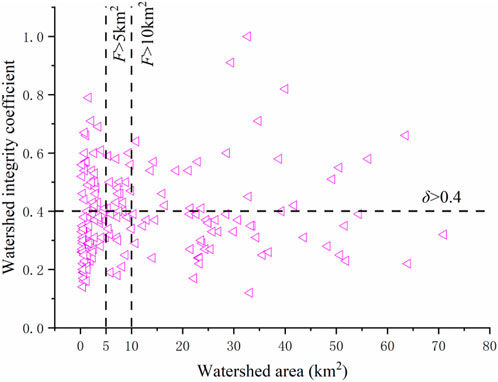
FIGURE 3. Watershed integrity coefficients versus watershed area of 176 channel-type debris flow gullies in the meizoseismal areas.
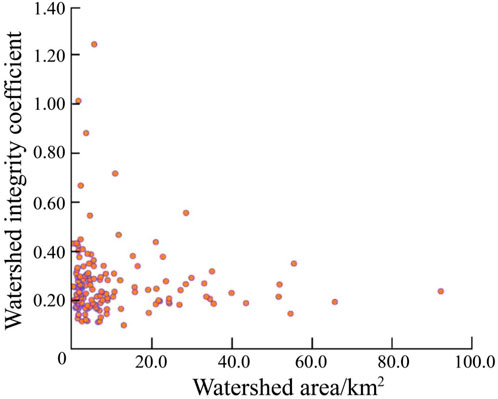
FIGURE 4. Watershed integrity factor and catchment area of 145 channel-type debris flows in the meizoseismal area (Chen et al., 2018).
3.4 Relative elevation difference of catchment
Yang et al. used the condition
3.5 Main channel length and average watershed width
The length of the main channel determines the flow length of the debris flow and the volume of erosion sources along the way, reflecting its energy and destructive power. From the 176 cases, 109 (61.9%) have a main gully length less than 5 km, showing the short gully is the main feature of the debris flow gullies in the meizoseismal area. Figure 5 indicates that the main channel length and watershed area satisfies a linear distribution with a positive correlation (R2=0.84). Their control effect on debris flow outbreaks is similar. With the decrease of the watershed area, the main channel length gets short, making it unfavorable to store loose material while conducive to debris flow initiation. Under the condition of narrow-steep gully F<5 km2, the main gully length satisfies L<5 km. Since the main gully length strongly correlates with the watershed area, L<5 km is used in this paper as a secondary discriminant condition.
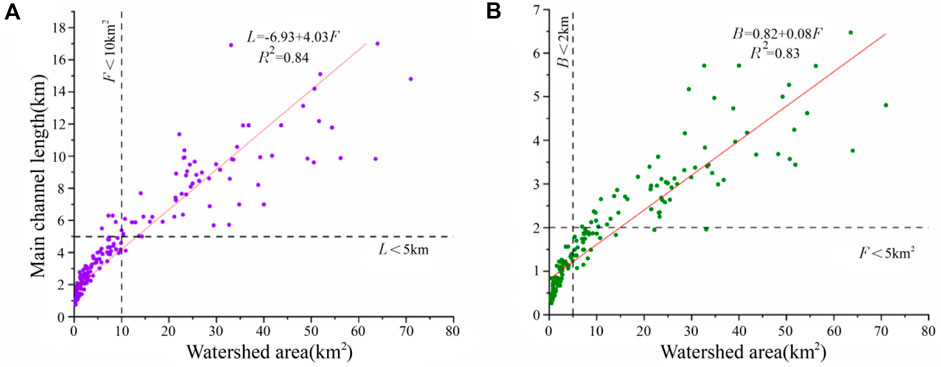
FIGURE 5. (A) Main channel length versus Watershed area (B) Average watershed width versus Watershed area.
The equation B=F/L can calculate the average watershed width because the main channel length is consistent with the watershed length. Figure 5 shows 63.6% (112) gullies are satisfied with condition B<2 km, indicating that the long-narrow basin form is typically characteristic of gullies in the meizoseismal area. The relationship of watershed area and average watershed width satisfy a linear distribution (R2=0.83) and under the condition of F<5 km2 for narrow-steep gullies, the average basin widths all satisfy B<2 km, so B<2 km is used as a secondary discriminant.
4 Rainfall and source characteristics
Wenchuan meizoseismal area belongs to tectonically eroded mid-alpine landscapes, and the topography significantly influences the climate. When encountering mountains, the air current lift results in clouds and rainfall, so the precipitation and rainy days increase with mountain elevation (Gu et al., 2005). Local heavy rainfall is mainly concentrated in the debris flow gullies catchment area. Therefore, the heavy rainfall that triggers debris flow is characterized by concentrated precipitation areas, rapid confluence, and uneven spatial distribution, which are highly favorable to the occurrence of debris flows (Zhang et al., 2014).
The rainfall in Wenchuan meizoseismal area is abundant. The average annual precipitation for the last 56 years is 719. 70 mm, with a large inter-annual variation and an oscillating upward trend. Statistics show that the average annual rainfall before the earthquake was about 716 mm, and the average annual rainfall from 2008 to 2017 after the earthquake was 752. 61 mm, which has increased by 5. 17% compared with the pre-earthquake period. With more precipitation, the loose hills are more prone to geological hazards (Guo et al., 2017). As shown in Figure 6, precipitation during the year was mainly concentrated between June and September. Approximately 70% of precipitation occurs in this period (Tang et al., 2016). Previous studies found that the critical rainfall intensity of debris flow is between 15.8 and 56.5 mm/h in the Wenchuan meizoseismal area. Also, the annual thresholds for debris flows have increased each year over the past years loose vegetation recovered (Guo et al., 2016).
Debris flow outbreaks result from the combined effect of the previously accumulated rainfalls and the recent rainfalls (Jiang et al., 2021; Li et al., 2021). The short duration with high-intensity rainfall plays a decisive role in triggering debris flows. This precipitation process can rapidly form larger flood peaks within a certain range of the debris flow basin, which induces the loose deposits to be piled up in the gully or washed out. Besides, the continuous light rainfall that often occurs during the rainy season in the meizoseismal areas saturates the water content of loose soil, increases its volume weight, reduces its shear strength and stability, resulting in a reduction in the critical rain intensity required to trigger debris flow, which facilitates debris flow activity.
The sources in the study area are mainly divided into landslide accumulation sources, channel accumulation sources, and slope erosion sources. Due to the increase in adverse geological phenomena caused by the strong earthquake, both the landslide deposit and channel deposit sources increased significantly. The proportion of dynamic storage also increased, providing a large amount of loose material for debris flow formation, resulting in a significant increase in the risk of channel-type debris flow in the meizoseismal area (Chen et al., 2012). In addition, during the earthquake, the mountain body was cracked and loosened under seismic waves, resulting in many critical slope bodies that were cracked but not slippery. Under the action of rainfall and self-weight, those potential sources will be disintegrated and piled up in the gully, recharging the sources in stages.
In terms of the source distribution, gully-type debris flow in the meizoseismal area has a concentrated source distribution, mainly accumulating in the gully, which is unstable. Compared to the wide-gently gullies, the narrow-steep gullies have a smaller catchment area but a larger storage capacity per unit area. For example, compared with Qipan gully, which has a watershed area of 54.2 km2 and a dynamic storage capacity of 130,000 m3/km2 of loose material per unit area, the narrow-steep Maliu gully has a watershed area of 1.6 km2 and a dynamic storage capacity of 940,000 m3/km2 of loose material per unit area, and the “7.10” debris flow washed out 100.58 million m3 of solid material at one time (Zhang et al., 2012).
Five typical gully-type debris flows gullies were selected from the two massive debris flows in Yingxiu Township, Mianhao Township, and Yinxing Township in the Wenchuan meizoseismal area 2010.08.13 and 2013.07.10. The screening experiment was carried out on these gullies, and the gradation curves were obtained as shown in Figure 7. The gradation of solid particles from the deposition sources in the meizoseismal area is widely distributed and has good continuity. The gradation curves have an inhomogeneity coefficient greater than 5 and a curvature coefficient between 0.95 and 3, with no missing particle groups. The content of fine particles less than 0.075 mm is less than 0.5%, and the content of sticky particles less than 0.005 mm is less than 0.11%, with slight differences between different gullies. Most of the source particle size is smaller than pre-earthquake, and the loose solid material is mainly the mixture of block gravel and soil. The proportion of rock blocks is large, while the total amount of less than 200 mm blocks is also relatively large, which is easy to initiate.
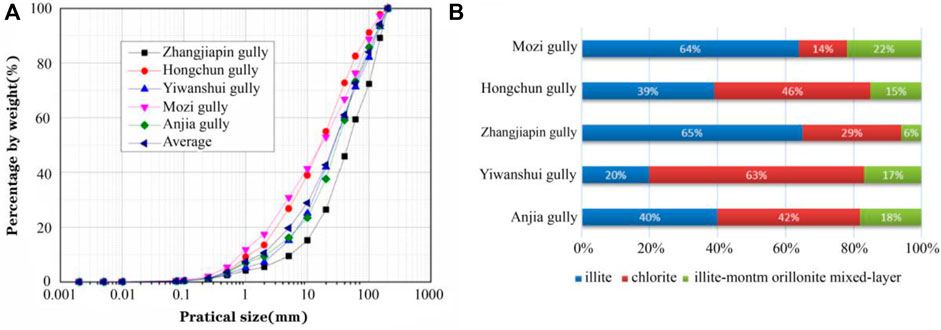
FIGURE 7. (A) The gradation curves of five gullies (B) Clay mineral composition of the deposit source in the meizoseismal area.
Webb et al. (2008) investigated the relationship between the clay mineralogy and major-cation chemistry of fine-grained bedrock units and the occurrence of debris flows on the entire Colorado Plateau, finding that the debris flow producers are uniformly low in montmorillonite (5%) and high in illite and kaolinite (71%); conversely, fine-grained bedrock that does not produce debris flows has lower illite and kaolinite (25%) and higher montmorillonite (51%) content. Analysis of the clay mineral composition of the deposit source in the meizoseismal area by X-ray diffraction experiments revealed that it is mainly composed of three clay minerals (Figure 7): illite, chlorite, and illite-montmorillonite mixed-layer, with an average content of 45.6%, 38.8%, and 15.6% respectively. The total contents of illite and chlorite are over 75%, while the contents of illite-montmorillonite mixed-layer are below 25%, which indicates the clay mineral composition in the meizoseismal area is favorable to the formation of debris flow.
5 Discrimination method of gully-type debris flows in the meizoseismal area
Identifying the gullies type plays a vital role in understanding the mechanism of debris flow and designing corresponding prevention engineering. The existing discrimination methods are always empirical and have defects such as inconsistent selection of indicators and conflicting identification rules. Based on the topographic feature of the 176 gullies in the meizoseismal area, the research for the discrimination method of debris flow gullies was carried out in this section.
The watershed area and average vertical slope of the channel, which reflect the character of width and slope, are selected as the main discrimination indicators in empirical discrimination. The average watershed width and main channel length are selected as secondary discrimination indicators. Table 2 shows the discrimination method. When the two main indexes belong to the same category, they can be discriminated directly. When one main index belongs to transitional, while the other one belongs to the other type, it can be discriminated to be narrow-steep or wide-gentle type. When there is a conflict between the two main indexes, comprehensive empirical discrimination should be made based on the specific values of the two indicators combined with the secondary index.
In using the empirical discriminant method to discriminate channel-type debris flows in the meizoseismal areas, the traditional empirical method needs to rely on the subjective human experience to make comprehensive judgments, particularly for cases where the results of two discriminant indicators are inconsistent. Take the Banqiao gully (watershed area: 26.96 km2, average vertical slope: 332‰) as an example. It has the characteristics of “steep” as the slope exceeds 300‰; however, its watershed area is much larger than 10 km2, which indicates the “wide” characteristic is more prominent, so it is categorized as the wide-gentle type. Although the empirical discrimination method can identify the gully type, it relies on subjective experience because of the terrain complexity, which reduces the applicability of the method. Therefore, based on the empirical discriminant method, a novel mathematical discriminant model is proposed by further analyzing and selecting the key discriminant indicators.
There are two functional relations in the four indicators describing the width of the gully (including watershed area, average watershed width, watershed integrity coefficient, and main channel length), displayed as
From the classification criteria of the improved empirical discrimination method, the narrow-steep gullies have characteristics of
Han et al. (2018) investigated 13 debris flows gullies outbreaking along the Duwen expressway on 10 July 2013, and classified them into two categories: wide-gentle and narrow-steep type by analyzing their characteristics. Table 3 verified the accuracy of the two discrimination methods proposed in this paper by applying them to the 13 gullies. For narrow-steep gullies (e.g., Mozi gully, Anjia gully), both methods can identify them well, while for wide-gentle gullies, there are a few differences between the discriminant method and the results from Han, et al. The inconsistence gullies like Huaxi gully (main channel length: 5.15 km, watershed area: 10.39 km2, average vertical slope: 287%) are charactered by medium-scale watershed area and relative gentle slope, which is defined as a transitional type. The discrimination methods proposed in this paper can better reflect the overall characteristics of gullies, then facilitates the targeting of prevention engineering.
The discrimination methods are applied to the 176 cases, and the results are shown in Tab X. For the empirical discrimination method, the number of narrow-steep channel type, transitional channel type, and wide-gentle channel type is 105 (59.66%), 12 (6.82%), and 59 (33.52%), respectively. While for GGI, the distribution of the result is 104 (59.09%), 16 (9.09%), and 56 (31.82%), respectively. Figure 8 shows the classification results of 176 gullies by the two methods, which is essentially in agreement.
Figure 9 shows the amount of source storage per km2 for three types of debris flow gullies. The average volume of narrow-steep, transitional, and wide-gentle debris flow gully are 117.12×104 m3/km2, 48.76×104 m3/km2, and 13.46×104 m3/km2, respectively. The source storage capacity per unit area of narrow-steep debris flow gully is 8.7 times greater than that of the wide-gentle type, which indicates the narrow-steep gully is more prone to debris flow occurrence.
6 Discussion
Narrow-steep debris flow gullies are always taking the shape of “V”, characterized by small watershed area (F < 5 km2), large longitudinal slope (I>300‰), significant relative height difference (H>1000), and the main channel length is generally less than 5 km (Figure 10). The bank slope is steep, leading the runoff generation and concentration rapidly and the source transport fast, thus the debris flow outbreaks suddenly. Due to the narrow width of the gully (5–30 m), it is more likely to erode the bank slope (Lyu et al., 2017), which further enhances the destructive capacity of debris flow. In the aspect of movement characteristic, the narrow-steep type debris flow is characterized by downward erosion and retrogressive erosion owing to the steep terrain, with no chance for deposition. Therefore, the focus of management should be on the control of undercutting and anadromous erosion of the gully.
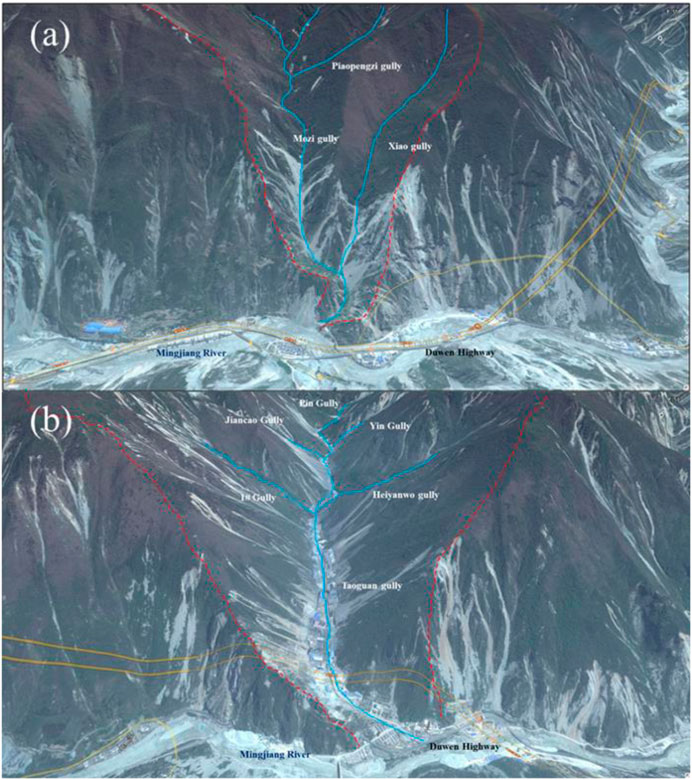
FIGURE 10. The typical narrow-steep and wide-gentle debris flow gullies: (A) The typical narrow-steep debris gully: Mozi gully (the watershed area: 7.4 km2, the average vertical slope: 424‰, with “V” shaped section) (B) The typical wide-gentle debris gully: Taoguan gully (the watershed area: 50.86 km2, the average vertical slope: 197‰, with “U” shaped section).
Wide-gentle debris flow gullies are mostly “U” shaped, with characters of big watershed area (F>10 km2), gentle longitudinal gradient (I<200‰), and long main channel length (Figure 10). Generally, this type has broad gully bottom and multiple tributary ditches, which tend to form cascade failure under heavy rainfall. The movement characteristic of wide-gentle type debris flow is mainly deposition. The scale of the outflow is huge, so it permanently blocks the river and forms barrier lakes. The multi-stage dam can effectively prevent the formation of barrier lakes and reduce the risk of collapse.
The current large-scale debris flow with a large watershed area, long main channel length, and gentle longitudinal slope are the future development trend of some small-scale debris flow with a small watershed area, short main gully length, and steep longitudinal slope. Lyu et al. (2022) found that the frequency of debris flow occurrence is closely related to the stage of gully evolution. As the watershed area grows, the frequency gradually increases until the watershed area reaches medium scale, which is assumed to be the morphologically most active gullies with the highest growth and incision rate. Then, as the watershed area further grows, the watershed morphology gradually stabilizes, and the mudflow frequency decreases affected by the milder gully gradient (Stock and Dietrich, 2006). From the perspective of the gully evolution stage, the narrow-steep debris flow gully is currently in its young-adult stage. With the strong downward erosion, lateral erosion, and retrogressive erosion, the gully gradually becomes longer and wider, reflecting the characteristics of transitional debris flow gully as the gully evolution enters its late stage, the debris flow gully evolute to wide-gentle debris flow gully with low frequency of debris flow occurrence.
Comparing the results of the mathematical model and empirical discriminating method on 176 samples, it was found that for all three types of gullies, the results from these two methods were generally consistent with each other. Several inconsistent cases (Table 4) were found at the boundaries of the discriminant criteria, which have a character between narrow-steep and wide-gentle types. It can be seen that compared with the empirical discriminating method, the mathematical model (GGI) can better classify the transitional type gullies. And form the aspect of operativity, the mathematical model is more practical and thus can be better used in the later remediation of debris flows in the meizoseismal area.
The preventive measures taken for different types of debris flow gullies are also different. For the wide-gentle gully type of debris flow, the management concept of “stopping mainly, supplemented by drainage” is used. For the narrow-steep type gully debris flows, the management concept of “consolidating the source and slope in the gully and stopping the siltation at the mouth of the gully” is used (Han 2016). For transitional mudslides, the above engineering measures can be chosen according to the actual situation.
In this paper, the proposed methods for classifying the gullies type in the meizoseismal area are based on the geomorphological perspectives. The sample quantity and study area restrict them. Further research should be conducted by expanding the sample size, combining DEM data with deep learning neural network algorithm (Chowdhuri et al., 2021; Saha et al., 2021; Chakrabortty et al., 2022).
7 Conclusion
Debris flow is a natural disaster that is widely distributed in some areas of the world with special topography and geomorphological conditions. Different types of debris flows should be subject to different control measures. Therefore, the study of mudslide discrimination methods is crucial. This paper collected 176 channel-type debris flow events in the meizoseismal area since 2008. Based on the analysis of gully character, two discrimination methods were proposed, and the following conclusions can be drawn:
(1) The gully-type debris flows in the meizoseismal area are characterized by small watershed areas, long strips, and steep longitudinal slopes, most of which have relative height differences greater than 1000 m, making them highly susceptible to debris flow. The short-duration, high-intensity rainfall in concert with continuous light rainfall is more conducive to debris flow formation. Besides, due to the earthquake disturbance, the sources in the meizoseismal area have increased significantly compared to the pre-earthquake period, and the clay mineral composition is favorable to the formation of debris flow.
(2) The debris flow gullies in meizoseismal area are classified as narrow-steep, transitional and wide-gentle types based on the topographical features. Narrow-steep debris flow gullies are mostly “V” shaped, with a small watershed area, steep channel slope, and narrow circulation channels. The debris flow moves fast in the channel, making it easy to form downward and lateral erosion. Wide-gentle debris flow gullies are mostly “U shape, with a larger basin area and gentler channel slope, the debris flow is easy to deposit in the channel, forming cascade failure and blocking the river. As the transitional stage of gully evolution, the transitional debris flow gully showed scour and deposition characteristics simultaneously. The source storage capacity per unit area of narrow-steep debris flow gully is 8.7 times greater than that of the wide-gentle type, indicating the narrow-steep gully is more prone to debris flow occurrence.
(3) The mathematical discrimination model named Gully Geomorphology Index (GGI) was constructed, and the value 0.05 and 0.10 were defined as the threshold of Narrow-steep, transitional and wide-gentle type gullies. Empirical method was applied to the 176 cases, showing the number of narrow-steep channel type, transitional channel type, and wide-gentle debris flow gullies are 105 (59.66%), 12 (6.82%), and 59 (33.52%), respectively. While for GGI, the distribution of discrimination results is 104 (59.09%), 16 (9.09%), and 56 (31.82%), which can better classify the transitional type gullies and is more practical.
At present, the world is encountering extreme climate and frequent natural disasters. The rapid identification of natural disasters is conducive to establishing a prevention and control system faster, and is of great significance to disaster prevention and reduction projects. The discrimination methods of narrow steep gully type debris flow and wide gentle gully type debris flow proposed in this paper greatly improve the speed of debris flow type discrimination, and the existing data show that these two methods have high reliability. We can use these two methods to construct numerical or experimental models of different debris flow gullies to further investigate their movement mechanisms and control measures. So as to promote the development of disaster prevention and reduction projects.
Data availability statement
The datasets presented in this study can be found in online repositories. The names of the repository/repositories and accession number(s) can be found in the article/supplementary material.
Author contributions
GX, DL, JJ, and QY planned the campaign; DL and JJ collected and analyzed the data; DL and MM wrote the manuscript draft; SQ, HL and QY reviewed and edited the manuscript.
Funding
This work is supported by the National Key R&D Program of China (2018YFC1505402), Sichuan Provincial International Science and Technology Collaboration & Innovation Project (2022YFH0078), National Natural Science Foundation of China (No. 51809188).
Conflict of interest
JJ was employed by Sichuan Water Resources and Hydroelectric Investigation and Design Institute Co., Ltd, China. DL was employed by Yalong River Hydropower Development Company, Ltd, China.
The remaining authors declare that the research was conducted in the absence of any commercial or financial relationships that could be construed as a potential conflict of interest.
Publisher’s note
All claims expressed in this article are solely those of the authors and do not necessarily represent those of their affiliated organizations, or those of the publisher, the editors and the reviewers. Any product that may be evaluated in this article, or claim that may be made by its manufacturer, is not guaranteed or endorsed by the publisher.
References
Chakrabortty, R., Pal, S. C., Santosh, M., Roy, P., and Chowdhuri, I. (2022). Gully erosion and climate induced chemical weathering for vulnerability assessment in sub-tropical environment. Geomorphol. (Amst). 398, 108027–555X. doi:10.1016/j.geomorph.2021.108027
Chang, T. C., Wang, Z. Y., and Chien, Y. H. (2009). Hazard assessment model for debris flow prediction. Environ. Earth Sci. 60 (8), 1619–1630. doi:10.1007/s12665-009-0296-x
Chen, M., Tang, C., Gan, W., and Cai, Y. (2018). Characteristics and dynamical process of debris flow at urgent steep gully in the earthquake areas—Illustrated with case of wayao gully in wenchuan. J. J. Yunnan Univ. 40 (2), 272–278. doi:10.7540/j.ynu.20170495
Chen, N-S., Hu, G-S., Deng, M-F., Zhou, W., Yang, C-L., Han, D., et al. (2012). Impact of earthquake on debris flows — A case study on the wenchuan earthquake. J. Earthq. Tsunami 05 (05), 493–508. doi:10.1142/S1793431111001212
Chengdu Institute of mountain hazards and environmentChinese Academy of Sciences (1989). Research and control of debris flow. Sichuan: M. Sichuan Science and Technology Press.
Chowdhuri, I., Pal, S. C., Arabameri, A., Saha, A., Chakrabortty, R., Blaschke, T., et al. (2020). Implementation of artificial intelligence based ensemble models for gully erosion susceptibility assessment. Remote Sens. (Basel). 12 (21), 3620. doi:10.3390/rs12213620
Chowdhuri, I., Pal, S. C., Saha, A., Chakrabortty, R., and Roy, P. (2021). Evaluation of different DEMs for gully erosion susceptibility mapping using in-situ field measurement and validation. J. Ecol. Inf. 65, 101425. doi:10.1016/j.ecoinf.2021.101425
Fan, X., Juang, C. H., Wasowski, J., Huang, R., Xu, Q., Scaringi, G., et al. (2018). What we have learned from the 2008 wenchuan earthquake and its aftermath: A decade of research and challenges. Eng. Geol. 241, 25–32. doi:10.1016/j.enggeo.2018.05.004
Gu, X., Tian, N., and Pan, P. J. (2005). “Climatic characteristics of rainstorms in Qian southeast China in the last 40 years and its topographic influence on the distribution of rainstorms,” in Proceedings of the 2005 Annual Meeting of the Chinese Meteorological Society, October 2005, Suzhou, China, 6529–6535.
Guo, X., Cui, P., Li, Y., Fan, J., Yan, Y., and Ge, Y. (2016). Temporal differentiation of rainfall thresholds for debris flows in Wenchuan earthquake-affected areas. Environ. Earth Sci. 75 (2), 109. doi:10.1007/s12665-015-5031-1
Guo, X., Cui, P., Marchi, L., and Ge, Y. (2017). Characteristics of rainfall responsible for debris flows in Wenchuan Earthquake area. Environ. Earth Sci. 76 (17), 596. doi:10.1007/s12665-017-6940-y
Han, M. (2016). Hazard mechanism research of wide-gentle and narrow-steep channels debris flow in wenchuan earthquake region. Sichuan Chengdu: D. Southwest Jiaotong University.
Han, M., Hu, X., and Hu, K. (2018). Comparative study between debris flow of wide-gentle and narrow-steep channel based on numerical simulation and prevention measures. J. Nepal Geol. Soc. 55, 167–172. doi:10.3126/jngs.v55i1.22808
Huang, R., and Li, W. (2014). Post-earthquake land sliding and long-term impacts in the Wenchuan earthquake area, China. Eng. Geol. 182, 111–120. doi:10.1016/j.enggeo.2014.07.008
Jiang, Z., Fan, X., Siva Subramanian, S., Yang, F., Tang, R., Xu, Q., et al. (2021). Probabilistic rainfall thresholds for debris flows occurred after the Wenchuan earthquake using a Bayesian technique. Eng. Geol. 280, 105965. doi:10.1016/j.enggeo.2020.105965
Koi, T., Hotta, N., Ishigaki, I., Matuzaki, N., Uchiyama, Y., and Suzuki, M. (2008). Prolonged impact of earthquake-induced landslides on sediment yield in a mountain watershed: The Tanzawa region, Japan. Geomorphol. (Amst). 101 (4), 692–702. doi:10.1016/j.geomorph.2008.03.007
Li, L., Yu, B., Zhu, Y., Chu, S., and Wu, Y. (2014). Topographical factors in the formation of gully-type debris flows in Longxi River catchment, Sichuan, China. Environ. Earth Sci. 73 (8), 4385–4398. doi:10.1007/s12665-014-3722-7
Li, N., Tang, C., Gong, L., Yang, C., Chen, M., and Gan, W. (2020). An experimental study of starting characteristics of steep-channel debris flow: A case study of the flow: A case study of the futang gully in the wenchuan county. J. Acta Geol. Sin. 94 (02), 634–647. doi:10.19762/j.cnki.dizhixuebao.2019146
Li, Y., Liu, X-n., Gan, B-r., Wang, X-k., Yang, X-g., Li, H-b., et al. (2021). Formation-evolutionary mechanism analysis and impacts of human activities on the 20 August 2019 clustered debris flows event in wenchuan county, southwestern China. Front. Earth Sci. (Lausanne). 9, 616113. doi:10.3389/feart.2021.616113
Liao, F. W., Liu, X., and Liu, P. (2011). Comprehensive mathematical evaluation on risk of debris flow. Adv. Mat. Res. 368-373, 829–833. doi:10.4028/www.scientific.net/AMR.368-373.829
Liu, F. Z., Xu, Q., Dong, X. J., Yu, B., and Frost, J. D. Li H. J. (2017). Design and performance of a novel multi-function debris flow mitigation system in Wenjia Gully, Sichuan. Landslides 14 (6), 2089–2104. doi:10.1007/s10346-017-0849-0
Loche, M., Scaringi, G., Yunus, A. P., Catani, F., Tanyaş, H., Frodella, W., et al. (2022). Surface temperature controls the pattern of post-earthquake landslide activity. Sci. Rep. 12 (1), 988–1011. doi:10.1038/s41598-022-04992-8
Lombardo, L., Bakka, H., Tanyas, H., van Westen, C., Mai, P. M., and Huser, R. (2019). Geostatistical modeling to capture seismic-shaking patterns from earthquake-induced landslides. J. Geophys. Res. Earth Surf. 124 (7), 1958–1980. doi:10.1029/2019JF005056
Lyu, L., Wang, Z., Cui, P., and Xu, M. (2017). The role of bank erosion on the initiation and motion of gully debris flows. Geomorphol. (Amst). 285, 137–151. doi:10.1016/j.geomorph.2017.02.008
Lyu, L., Xu, M., Wang, Z., Cui, Y., and Blanckaert, K. (2022). A field investigation on debris flows in the incised Tongde sedimentary basin on the northeastern edge of the Tibetan Plateau. Catena (Amst). 208, 105727. doi:10.1016/j.catena.2021.105727
Ni, H., Tang, C., Zheng, W., Xu, R., Tian, K., and Xu, W. (2014). An overview of formation mechanism and disaster characteristics of post-seismic debris flows triggered by subsequent rainstorms in wenchuan earthquake extremely stricken areas. Acta Geol. Sin. - Engl. Ed. 88 (4), 1310–1328. doi:10.1111/1755-6724.12290
Pal, S. C., Arabameri, A., Blaschke, T., Chowdhuri, I., Saha, A., Chakrabortty, R., et al. (2020). Ensemble of machine-learning methods for predicting gully erosion susceptibility. Remote Sens. (Basel). 12 (22), 3675. doi:10.3390/rs12223675
Qi, S., Chen, X., Simms, P., Zhou, J., and Yang, X. (2020). New method for determining the permeability function parameters of soft soils considering synchronous sedimentation and consolidation. Comput. Geotechnics 127, 103781. doi:10.1016/j.compgeo.2020.103781
Qu, Y., and Xiao, J. (2018). The preliminary study on characteristics of urgent steep-channel debris flows in meizosismal area. J. Chang. Inst. Tech.(Nat. Sci. Edi.) 19 (4), 57–61. doi:10.3969/j.issn.1009-8984.2018.04.014
Roy, P., Chakrabortty, R., Chowdhuri, I., Malik, S., Das, B., and Pal, S. C. (2020). “Development of different machine learning ensemble classifier for gully erosion susceptibility in gandheswari watershed of West Bengal, India,” in Machine learning for intelligent decision science. Algorithms for intelligent systems. Editors J. Rout, M. Rout, and H. Das (Singapore: Springer). doi:10.1007/978-981-15-3689-2_1
Saha, A., Pal, S. C., Arabameri, A., Chowdhuri, I., Rezaie, F., Chakrabortty, R., et al. (2021). Optimization modelling to establish false measures implemented with ex-situ plant species to control gully erosion in a monsoon-dominated region with novel in-situ measurements. J. Environ. Manage. 287, 112284–114797. doi:10.1016/j.jenvman.2021.112284
Stock, J. D., and Dietrich, W. E. (2006). Erosion of steepland valleys by debris flows. Geol. Soc. Am. Bull. 118 (9-10), 1125–1148. doi:10.1130/B25902.1
Takahashi, T. (1980). Debris flow on prismatic open channel. J. Hydr. Div. 106 (3), 381–396. doi:10.1061/jyceaj.0005381
Tang, C., van Asch, T. W. J., Chang, M., Chen, G. Q., Zhao, X. H., and Huang, X. C. (2012). Catastrophic debris flows on 13 August 2010 in the Qingping area, southwestern China: The combined effects of a strong earthquake and subsequent rainstorms. Geomorphol. (Amst). 139-140, 559–576. doi:10.1016/j.geomorph.2011.12.021
Tang, C., Van Westen, C. J., Tanyas, H., and Jetten, V. G. (2016). Analyzing post-earthquake landslide activity using multi-temporal landslide inventories near the epicentral area of the 2008 Wenchuan earthquake. Nat. Hazards Earth Syst. Sci. 16 (12), 2641–2655. doi:10.5194/nhess-16-2641-2016
Tang, C., Zhu, J., Li, W. L., and Liang, J. T. (2009). Rainfall-triggered debris flows following the Wenchuan earthquake. Bull. Eng. Geol. Environ. 68 (2), 187–194. doi:10.1007/s10064-009-0201-6
Wang, Y., Nie, L., Zhang, M., Wang, H., Xu, Y., and Zuo, T. (2020). Assessment of debris flow risk factors based on meta-analysis—cases study of northwest and southwest China. Sustainability 12 (17), 6841. doi:10.3390/su12176841
Webb, R. H., Griffiths, P. G., and Rudd, L. P. (2008). Holocene debris flows on the Colorado Plateau: The influence of clay mineralogy and chemistry. Geol. Soc. Am. Bull. 120 (7-8), 1010–1020. doi:10.1130/B26055.1
Wu, S. R., Shi, J. S., and Wang, H. B. (2011). Analysis of activity intensity for landslides triggered by the Wenchuan earthquake, Sichuan Province, China. Environ. Earth Sci. 65 (4), 1021–1028. doi:10.1007/s12665-011-0952-9
Xiong, J., Tang, C., Chen, M., Zhang, X., Shi, Q., and Gong, L. (2020). Activity characteristics and enlightenment of the debris flow triggered by the rainstorm on 20 August 2019 in Wenchuan County, China. Bull. Eng. Geol. Environ. 80, 873–888. doi:10.1007/s10064-020-01981-x
Yang, D. X., Chen, X. Q., and You, Y. (2012). The debris flow development trend in xiaogangjian gully in Mianzhu county, wenchuan earthquake zone. J. J. Mt. Sci. 30 (06), 701–708. doi:10.3969/j.issn.1008-2786.2012.06.010
Yang, D., You, Y., Chen, X., Zhao, W., Shi, S., and Xie, Z. (2015). Typical characteristics and mitigation of debris flow in narrow-steep gullies in the Wenchuan earthquake areas. J. HYDROGEOLOGY Eng. Geol. 42 (01), 146–153. doi:10.16030/j.cnki.issn.1000-3665.2015.01.25
Yang, D., You, Y., Zhao, W., Huang, H., Sun, H., and Liu, Y. (2020). Abrasion behavior and anti-wear measures of debris flow drainage channel with large gradient. Water 12 (7), 1868. doi:10.3390/w12071868
Yin, Y., Cheng, Y., Liang, J., and Wang, W. (2015). Heavy-rainfall-induced catastrophic rockslide-debris flow at sanxicun, dujiangyan, after the wenchuan ms 8.0 earthquake. Landslides 13 (1), 9–23. doi:10.1007/s10346-015-0554-9
Zhang, Ning, Yao, Leihua, and Wang, Qing (2012). “Study on one-dimensional movement model of Maliu gully debris flow,” in International Symposium on Geomatics for Integrated Water Resource Management, Lanzhou, 19-21 Oct. 2012, 1–6. doi:10.1109/GIWRM.2012.6349611
Zhang, Y., Cheng, Y., Yin, Y., Lan, H., Wang, J., and Fu, X. (2014). High-position debris flow: A long-term active geohazard after the wenchuan earthquake. Eng. Geol. 180, 45–54. doi:10.1016/j.enggeo.2014.05.014
Zhao, B., Yu, B., Chang, M., and Yang, L. (2021). Characteristics of debris flow in narrow-steep channel. J. J. Sediment Res. 46 (5), 61–67. doi:10.16239/j.cnki.0468-155x.2021.05.010
Keywords: debris flow, narrow-steep gully, wide-gentle gully, discrimination method, gully geomorphological index
Citation: Xu G, Ji J, Luo D, Qi S, Li H, Dembele MDM and Yao Q (2023) Discrimination of debris flow in narrow-steep type and wide-gentle type gullies in Wenchuan meizoseismal area. Front. Earth Sci. 10:1004400. doi: 10.3389/feart.2022.1004400
Received: 27 July 2022; Accepted: 20 October 2022;
Published: 11 January 2023.
Edited by:
Changdong Li, China University of Geosciences Wuhan, ChinaReviewed by:
Ruilin Fan, Aecom United States, United StatesLuigi Lombardo, University of Twente, Netherlands
Subodh Chandra Pal, University of Burdwan, India
Copyright © 2023 Xu, Ji, Luo, Qi, Li, Dembele and Yao. This is an open-access article distributed under the terms of the Creative Commons Attribution License (CC BY). The use, distribution or reproduction in other forums is permitted, provided the original author(s) and the copyright owner(s) are credited and that the original publication in this journal is cited, in accordance with accepted academic practice. No use, distribution or reproduction is permitted which does not comply with these terms.
*Correspondence: Qiang Yao, eWFvcWlhbmc3NzdAc2N1LmVkdS5jbg==
 Guoqing Xu
Guoqing Xu Jiejie Ji
Jiejie Ji Dengze Luo4
Dengze Luo4 Shunchao Qi
Shunchao Qi